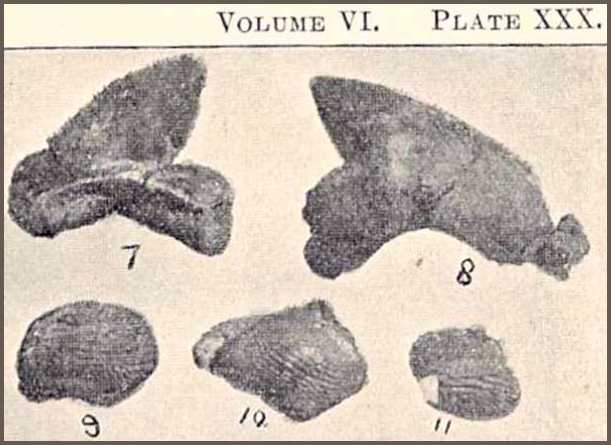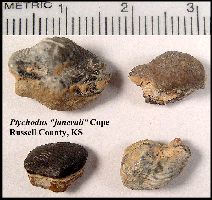
Dr. John H. Janeway, Surgeon, U.S. Army
 |
Dr. John H. Janeway, Surgeon, U.S. Army
Copyright © 2002-2009 by Mike EverhartePage last updated last: 07/12/2009 |
| ABOVE: Early photographs of Ptychodus janewayii Cope
1874 (Nos. 9, 10, 11), as figured Williston, 1900, Pl. 30. |
 |
LEFT: Recent (2006) pictures of the teeth (KUVP 55265) described by Cope (1874) as Ptychodus janevaii in the University of Kansas Museum of Natural History, Lawrence, Kansas. The original museum tag is HERE. A note on the tag suggests that the teeth came from the Graneros Shale, although it is more likely they were collected from the basal Lincoln Limestone Member of the Greenhorn Limestone. |
Early Paleontology in Western Kansas
From the official records of Fort Hays: Captain John H. Janeway was assigned to Fort Hays on July 5, 1871. Following a series of personal medical problems which resulted in his being absent for duty, the following request was entered into the daily report - "Letters Sent, 1-13-73, request made for an asst. to Janeway who suffers from acute and severe attacks of sickness often of many days duration." and "Letters Sent, 4-30-73, [Janeway] has been ill since the middle of March and is presently suffering from an attack of blindness." In spite his health problems, he was listed as "Post Surgeon" in the daily report until a notation on 6-24-74, referring to him as "Asst. Surgeon Janeway." He was transferred to Fort Wallace in August of 1874, but returned under mysterious circumstances. The entry in the daily report is as follows: "Letters Received, 12-17-74, [Janeway] arrived on the 7th, refusing to state his business for being at Ft. Hays. Refusal to give such information is a military offense & therefore he is subject to trial." Whatever the reason for or the outcome of this entry, Captain Janeway officially served at Fort Wallace from August, 1874, through July, 1875. Military records indicate that he served in the U.S. Army for at least 30 years (1861-1893) and reached the rank of Colonel. He is also noted as one of the founders of the Trenton Country Club in Trenton, N. J. in October of 1897.
Captain Janeway was probably the actual author of the following excerpt from an official U.S. Army document describing the environs of the various Army posts of the day. Janeway is lauded both by E. D. Cope and S. W. Williston (1898, p. 28) for his knowledge of the fossils in the vicinity of Fort Hays. In a letter to his wife, dated September 13, 1871, (reprinted in Osborn, 1931, p. 161), Cope writes, "I found Dr. Janeway the surgeon of the Fort, a New Jersey man, old member of the Academy of Natural Sciences, naturalist, etc. and cousin of Dr. Howell who is a most excellent adjunct to me. I am likely to get everything in the way of fossils, alcoholics [for preservation of biological specimens], etc., I have an abundance, plenty of alcohol, haversack, plenty of hammers, etc. Tomorrow the Dr. with a small party go over 15 miles to the Saline River where there are many fossils."
In Cope's "Review of the Vertebrata" (1874, p. 47-48), he names a new species of pavement toothed shark Sporetodus janevaii [probably Ptychodus mammillaris] in honor of Dr. Janeway. Cope wrote, "Discovered by Prof. B. F. Mudge, near Stockton [Rooks, Co.], Kansas, from a bed containing many teeth of Oxyrhina, [Cretoxyrhina], Lamna [Scapanorhynchus], & c, of small size. Dedicated to Dr. John H. Janeway, post-surgeon at Fort Hays, who has rendered much important aid to palaeontology and zoölogy in Kansas." Williston (1900, p. 242) re-described the species from new material and changed the name to Ptychodus janewayii Cope and indicated that the specimens figured on Plate XXX from a conglomerate near the contact of the "Dakota Sandstone and the Benton" in Ellsworth County.
In his Letter of Transmittal (January, 1875) to F. V. Hayden for his "Vertebrata of the Cretaceous Formations", Cope expressed his gratitude to Dr. Janeway and others. Cope (1875, p. 17-18) also commented about his "Kansas expedition of 1871", when he was 18 miles north of Fort Hays on the Saline River: "Fragments of fish-vertebrae of the Anogmius [Bananogmius] type were also found hereby Dr. J. H. Janeway, post-surgeon. These were exposed in the yellow bed. Several miles east of the post, Dr. Janeway pointed out to me an immense accumulation of Inoceramus problematicus in the blue stratum. This species also occurred in abundance in the bluffs west of the fort, which were composed of the blue bed, capped by a thinner layer of the yellow." (See Kansas 1872 map HERE).
Mechem, A. F. and J. H. Janeway, 1874. Reports of Surgeon A. F. Mechem and Assistant Surgeon J. H. Janeway, United States Army.
Excerpt from official U. S. Army document (?) published in 1874, Page 267
|
Fort Hays, Kansas
267 FORT HAYS, KANSAS REPORTS OF SURGEON A. F. MECHEM AND ASSISTANT SURGEON J. H. JANEWAY, UNITED STATES ARMY Fort Hays, in the central part of the State of Kansas - latitude 38° 59' north; longitude, 22° west, 1893 feet above the level of the sea - is located on a slightly elevated piece of ground a quarter mile from Big Creek, a branch of the Smoky Hill Fork of the Kansas River; ten miles north of the Smoky Hill Fork, and fifteen miles south of the Saline River, another branch of the Kansas. The nearest mountains are from two hundred to two hundred and fifty miles distant, in a westerly direction. The nearest post, Fort Larned, is forty-one miles southeast; Fort Dodge, almost eighty miles south, and Fort Wallace, one hundred and twenty seven miles west. Hays City, almost three quarters of a mile from the post, is the nearest station of the Kansas Pacific Railroad. Old Fort Hays, on Big Creek, fifteen miles east of this post, was established in the autumn of 1866 to protect the employes [sic] of the Kansas Pacific Railroad Company from the attack of Indians, and at first was named Fort Fletcher, in honor of ex-Governor Fletcher, of Missouri; but afterward, in the winter of 1866-'67, the name was changed to Fort Hays, in honor of Major General Isaac G. Hays [see note below], who was killed at the battle of the Wilderness. During the summer of 1867, it became necessary to abandon the site first chosen on account of a destructive overflow of Big Creek at that point. The present site of Fort Hays was selected by Brevet-Major General Gibbs, United States Army, major [sic?] Seventh United States Cavalry, June 22, 1867, by authority of Major General Hancock, commanding the Department of the Missouri. The reservation is irregularly triangular, extreme length is six miles, extreme breadth three and a half miles, and contains about 7,500 acres. This tract of land and country in the immediate vicinity are situated in a shallow basin surrounded by a low limestone ridge [Fort Hays Limestone, Niobrara Fm.], the distance from the post to the ridge varying from two to five miles. The surface of the reservation is gently undulating, and is traversed by numerous gullies running from the ridge to the creek, which convey the surface drainage of the reservation and the ground about the post. The geological formation includes a series of groups constituting the secondary mountain formation of the cretaceous system. This formation occurs at greater or less depths on reservation, but crops out throughout the whole extent of the ridge which surrounds the post. Overlying the cretaceous strata from above downward, we have dark, sandy loam, fine siliceous loam of a buff color [loess], yellow clay, and hard marly clay. Selenite, breccia, and conglomerates [Ogallala Fm., Tertiary] are found thinly scattered over the ground in the vicinity of the post. The soil is tolerably fertile in the bottoms, but unproductive, not so much for the want of rain as on account of the dry scorching winds which sweep the plains during the summer season. The trees grow almost exclusively along the banks of the streams, as there are but few other localities which are protected from the annual fires which sweep the plains. A few elms have been found in the ravines and cedars on the cliffs. The elm surpasses all other trees, both in beauty and number, on the bank of the creek near the post. The wild animals found near the post are three varieties of the common bat, the American wild cat, gray wolf, coyote, long-tailed weasel, common mink, American badger, raccoons, skunk, American otter, American beaver, striped gopher, prairie dog, wood rats, yellow haired porcupine, common American hare, jackass rabbit, American elk, [pronghorn] antelope, two varieties of the genus Cervus [White tailed and mule deer], and the American buffalo. The birds are the turkey buzzard, duck hawks, pigeon hawk, sparrow hawk, great horned owl, screech owl, burrowing owl, sapsucker, black woodcock, red headed woodpecker, red shafted flicker, whippoorwill, nighthawk, belted kingfisher, bee martin, robin, cliff swallow, mocking bird, red bird, cowbird, red-winged blackbird, western lark, crow blackbird, crow, blue jay, Carolina dove, wild turkey, dusky grouse, prairie chicken, sand hill crane, killdeer, wild goose, long billed curlew, blue winged teal, mallard. Editors note: This comment actually refers to Brevet Major-General Alexander Hays, U. S. Volunteers, killed May 5, 1864, at the Wilderness, Va. More about General Hays here. |
OOK Web-pages on the work of other early paleontologists in Kansas: Professor B. F. Mudge; Dr. George M. Sternberg; Dr. Theophilus Turner
References:
Cope, E. D. 1874. Review of the Vertebrata of the Cretaceous
period found west of the Mississippi River. U. S. Geol. Surv. Terr. Bull.
1(2):3-48.
Cope, E. D. 1875. The Vertebrata of the Cretaceous formations of the West. Report, U. S.
Geol. Surv. Terr. (Hayden). 2:302 p, 57 pls.
Osborn, H. F. 1931. Cope: Master naturalist - The life and letters
of Edward Drinker Cope. Princeton Univ. Press, Princeton, N.J., xvi and 740
p. 1978 reprint, Arno Press, New York.
Williston, S. W. 1898. Addenda to Part I in The University Geological Survey of Kansas, 4:28-32.
Williston, S. W. 1900. Cretaceous fishes [of Kansas]. Selachians and Pycnodonts. Univ. Geol. Surv. Kansas VI, pp. 237-256, pls. 23-73.